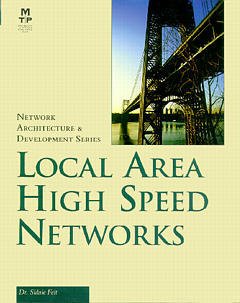Local area high speed networks
Langue : Anglais
Auteur : FEIT

There is a great deal of change happening in the technology being used for local networks. As Web intranets have driven bandwidth needs through the ceiling, inexpensive Ethernet NICs and switches have come into the market. As a result, many network professionals are interested in evaluating these new technologies for implementation consideration. They are looking for advice from experts who can help them realistically compare and decide how to use the options before them. Often, books on this subject are too varied in subject matter, attempting to cover to many subjects in the book. This book addresses the topic of Ethernet Networking from a planning perspective to a bit analysis of the Ethernet packets. It explains in detail information in the new network administrator would find it necessary to know.
PART I. ETHERNET, FAST ETHERNET, AND GIGABIT ETHERNET.
1. Introduction to LANs.
2. LAN MAC Addresses.
3. Ethernet LAN Structure.
4. The Classical Ethernet CSMA/CD MAC Protocol.
5. Full-Duplex Ethernet Communication.
6. The Ethernet 10 Mbps Physical Layer.
7. The Ethernet 100 Mbps Physical Layer.
8. Gigabit Ethernet Architecture.
9. Gigabit Ethernet Physical Layer.
10. Twisted Pair Cabling Standards and Performance Requirements.
11. Auto-Negotiation.
The Birth of Ethernet. Token Ring. Fibre Distributed Data Interface. Fibre Channel and ATM. Communication Layering Model. Basic LAN Components. SNMP. Monitors and RMON. Standards Body Overview.
2. LAN MAC Addresses.
Universally Administered MAC Addresses. Locally Administered MAC Addresses. Broadcast and Group Addresses. Individual/Group and Universal/Local Flag Bits. Ethernet Address Conventions. Token Ring Address Conventions. FDDI Address Conventions.
3. Ethernet LAN Structure.
Ethernet LAN Architecture.
4. The Classical Ethernet CSMA/CD MAC Protocol.
Classic Ethernet Shared Bandwidth LANs. Ethernet MAC Frames. Tabulation of Important Ethernet Parameters.
5. Full-Duplex Ethernet Communication.
Full-Duplex Architecture.
6. The Ethernet 10 Mbps Physical Layer.
Baseband Ethernet on Thick Coaxial Cable (10BASES). Baseband Ethernet on Thin Coax Cable (10BASE2). 10Mbps Twisted-Pair Ethernet (10Base-T). Building a Mixed Coax/Twisted-Pair Collision Domain. 10Mbps on Fiber Optic Cable.
7. The Ethernet 100 Mbps Physical Layer.
Coexistence and Migration with Auto-Negotiation. 100Mbps Ethernet on Twisted-Pair Cabling. 100BASE-FX and FDDI. Media Independent Interface. 100Mbps Collision Domain Diameter. 100VG-AnyLAN.
8. Gigabit Ethernet Architecture.
Gigabit Configurations. Full-Duplex Gigabit Ethernet. Half-Duplex Gigabit Ethernet.
9. Gigabit Ethernet Physical Layer.
Features of Gigabit Ethernet. Physical Characteristics of Gigabit Ethernet. 1000BASE-X Technology. 1000BASE-T Encoding.
10. Twisted Pair Cabling Standards and Performance Requirements.
Cabling Standards Bodies. TIA/EIA Categories. Unsheilded Twisted-Pair Cabling Performance Parameters. Managing Twisted-Pair Cabling. Testing Fiber Optic Cable.
11. Auto-Negotiation.
Auto-Negotiation for Twisted-Pair Interfaces. Auto-Negotiation for 1000BASE-X Interfaces.
PART II. BRIDGING, SWITCHING, AND ROUTING.
12. Ethernet Bridges and Layer 2 Switches.
13. The Spanning Tree Protocol.
14. Switches and Multicast Traffic.
15. Link Aggregation.
16. VLANs and Frame Priority.
17. Source-Routing.
18. Routing and Layer 2/3 Switches.
Main Bridge/Switch Functions. Other Bridge Functions. Transparent Bridge Internals. Layer 2 Switch Architecture. Building Redundancy into a LAN. Handling Multicasts.
13. The Spanning Tree Protocol.
LAN Structure and SubLANs. Protocol Overview. Elements of the Protocol. Protocol Messages.
14. Switches and Multicast Traffic.
Multicasting. IGMP Snooping. The GARP Multicast Registration Protocol (GMRP). Generic Attribute Registration Protocol.
15. Link Aggregation.
Using Link Aggregation. Link Aggregation Concepts and Procedures. Link Aggregation Parameters. The Link Aggregation Control Protocol.
16. VLANs and Frame Priority.
Virtual LAN Concepts. Implementing VLANs. Processing VLAN Frames. VLAN Protocol Elements. Assigning Priorities to Frames. GARP VLAN Registration Protocol Details.
17. Source-Routing.
Translational and Wide Area Bridges. Source-Routed Bridged LANs. Translational Bridges. Tunneling Token Ring Across Ethernet. Structuring a LAN Around a High-Speed Ethernet or FDDI. Remote Bridges.
18. Routing and Layer 2/3 Switches.
Features of Routing. Routing Procedures. Bridge/Routers. Layer 4 and Application-Layer Switching.
PART III. OTHER OLD AND NEW TECHNOLOGIES.
19. Token Ring and FDDI Overview.
Features of Classic Half-Duplex Token Ring. Classic Token Ring Protocol Elements. Dedicated Token Ring. High Speed Token Ring. Fiber Distributed Data Interface. FDDI Topology. FDDI P
- Expert Authorship.
- Author Sidnie Feit is a well-known figure in the networking community and well-regarded author of networking books.
- Realistic Content Application.
- Real-world implementation examples all students to compare and decide how to use each given technology.
- Practical Application.
- Covering more than the technological specifications, content offers perspective on the market variance of different networking topologies and product offerings, enabling students to make business-savvy and forward-looking decisions once they enter the work force.
Date de parution : 07-2000
Ouvrage de 670 p.
19x23 cm
Thème de Local area high speed networks :
© 2024 LAVOISIER S.A.S.
Ces ouvrages sont susceptibles de vous intéresser

Third Networks and Services 192,08 €


